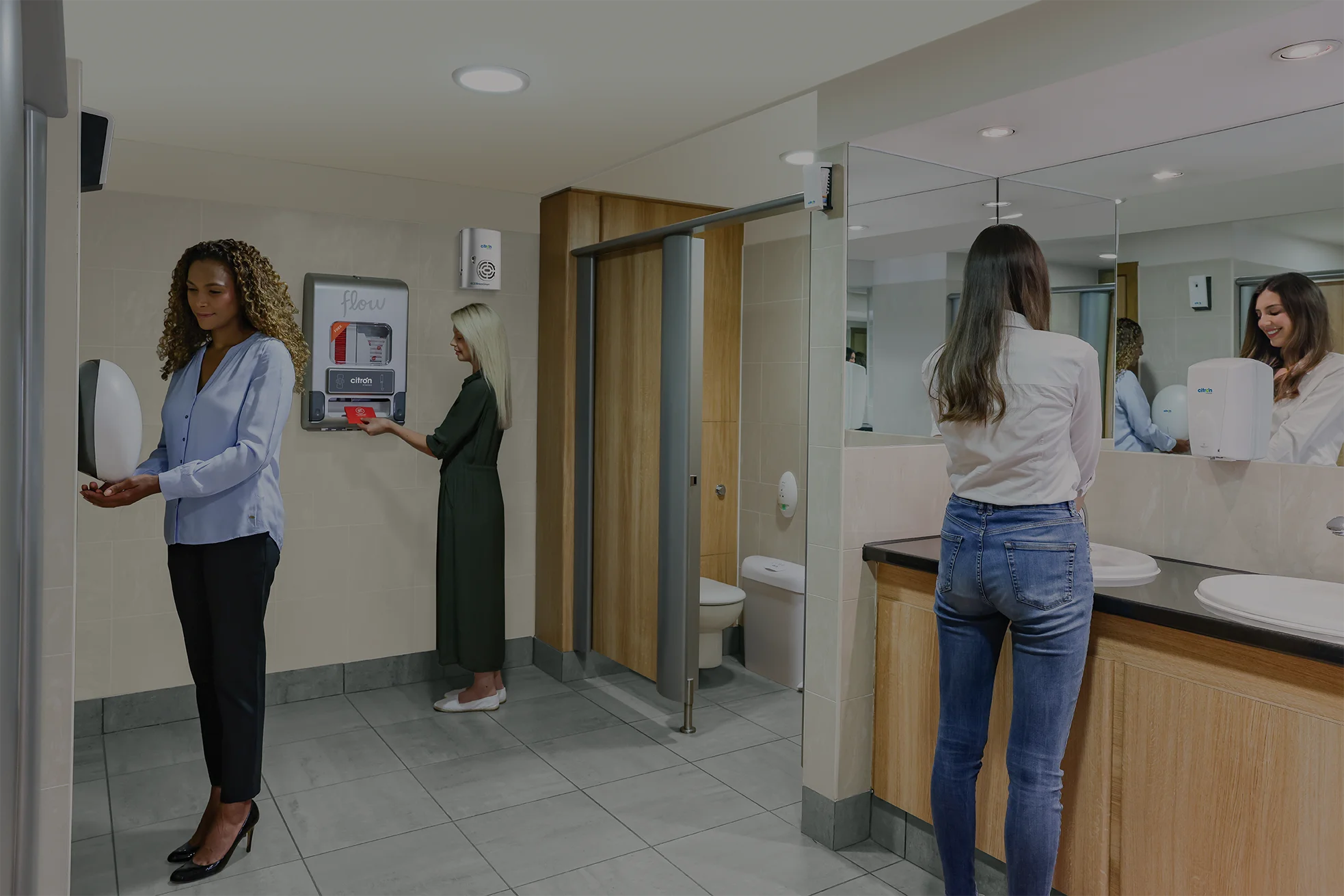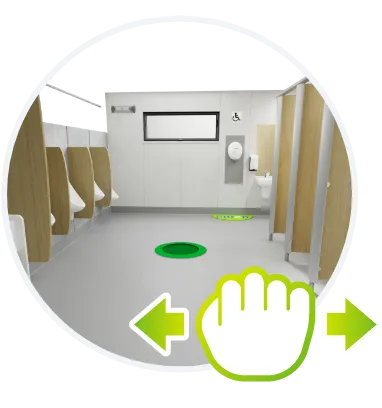There is no disputing that germs and bacteria are found everywhere we go. Whilst many of them are harmless and even helpful, there are many more that can make our lives miserable. Nowhere is this more evident than in public washrooms. So, how can you ensure that your washrooms are safe for your employees and visitors every day?
Although some germs and bacteria have been seen to be beneficial to humans, the ones found in your bathroom at home or public toilets can be potentially harmful. These germs and bacteria can cause illnesses such as strep throat and salmonella, with the biggest washroom culprits being E. coli and Staphylococcus Aureus. One study uncovered that poor cleaning techniques from maintenance workers, along with poor hand-washing practices, contribute to the high levels of germs and bacteria found in public toilets. Therefore, it is paramount that your washrooms are hygienic, cleaned, and sanitised to the highest standards to protect everyone within your establishment.
Read on to get a deeper understanding of the common germs and bacteria found within your public washroom and what you can do to minimise the risk of infection transmission.
Table of Contents
Why has there been a rise in viral infections?
Since the covid-19 pandemic, we’ve heard reports of increases in contagious viruses such as RSV, Strep A and the flu, particularly among young children. During the pandemic, children were unable to socialise outside of the home, preventing them from developing the antibodies they need to fight off viruses they might otherwise have been exposed to. In fact, figures from the UK Department of Health and Social Care showed a significant decrease in respiratory viruses during 2020 and 2021.
In a paper that appeared in the Journal Perspectives in Public Health, Prof. Sally F. Bloomfield and colleagues explain that:
“The immune system is a learning device, and at birth it resembles a computer with hardware and software but few data. Additional data must be supplied during the first year of life, through contact with microorganisms from other humans and the natural environment.”
Therefore, children need to be exposed to certain viruses and bacteria for their immune system to develop immunity against the most common illnesses they will have contact with. However, due to the restrictions placed on them during lock-down, their immune system has not had the chance to do so. Thus, a common and mild bacterial infection like Strep A is now able to cause more harm in children than before because they haven’t been able to give their immune system the chance to develop the resistance it needs to fight it off.
Consequently, establishments need to ensure their washroom hygiene and cleanliness is of paramount priority to prevent the spread of germs bacteria and keep everyone using their washrooms safe.
Facts about germs & bacteria in public toilets
The research into germs and bacteria in public toilets has been widespread since the 1960s, a Scientific American article by Rob Dunn claimed that an entire field of science should be undertaken to understand the story of bathroom germs. But what are germs?
What are germs?
The word “germ” encompasses a wide range of microscopic organisms, which can be split into four categories:
Bacteria
Bacteria are a tiny group of organisms that get their nutrients from the environment. Once they inhabit a living creature, they can cause urinary tract infections, ear infections, and strep throat.
Viruses
Viruses are smaller than bacteria and need to use other cell structures to reproduce, meaning they can’t survive unless they are living in something else, such as an animal, person, or plant. It also means that they can only survive for a short time outside of a living cell, such as on toilet seats and doorknobs. Once viruses get inside somebody’s body, they spread very easily. The illnesses they can give to their inhabitants include the flu, the common cold, and even HIV and smallpox.
Fungi
Fungi love hot and humid climates and thrive in damp conditions, which means they are more prevalent in poorly ventilated spaces. They release spores into the air, which can aggravate allergies and cause health problems such as athletes’ foot and yeast infections.
Protozoa
Protozoa are similar to bacteria, but they are larger and have a nucleus cell-like structure; they must live in another organism to survive, but they can also encase themselves in a cyst, allowing them to live outside in harsh environments for extended periods of time. They contribute to intestinal infections and other diseases like giardiasis and amebiasis, which are frequently transmitted through contaminated water.
Of these four categories, bacteria and viruses create the most diseases harmful to humans. They thrive whenever they find warmth, food, and moisture; in fact, a single gram of human faeces could contain up to 1,000,000,000,000 germs, and, once they get inside a body, they can breed very quickly.
Germs and bacteria found in public washrooms
How germs and bacteria are spread in public washrooms
Hands are the main culprit. One of the most easily transferred and highly infectious viruses is the flu or cold virus. Acco
rding to the Centre for Disease Control and Prevention, hands are responsible for about 80% of these infections. A surprising result in one study found that just washing hands with soap can reduce the risk of diarrheal diseases by 42 to 47%, which can save millions of lives from diarrhoea and similar infections.
How long can germs and bacteria survive in a public washroom?
According to the NHS, germs like salmonella and E. coli can survive on washroom surfaces for as long as four hours. However, some germs, such as the staph infection causing Staphylococcus aureus, can persist on surfaces for days or even weeks. On hard surfaces, other germs and bacteria that cause common viruses like the cold and flu can survive and stay contagious for up to 24 hours. Limiting the transmission of these germs and eliminating them before they cause harm through cross-contamination can be accomplished by regularly sanitising washroom surfaces and practising good hand hygiene.
Most common germ hotspots in washrooms
Did you know we spend around 11 days a year in washrooms at home and outside of the home; that is 264 hours we spend surrounded by potentially harmful germs? While toilets and flush handles can harbour bacteria, your sink can harbour 250,000% more bacteria than your toilet seat, therefore, it is important that you disinfect all areas in your washroom, even surfaces you didn’t think germs would cling to. This includes:
- Mirrors
- Toilet roll holders
- Waste bins
- Taps
- Floors
- Doorknobs
- Radiators
The toilet sneeze effect
Public washrooms contain millions of germs and bacteria that the human eye is unable to see. Transfer of germs from hand to surface is not the only cause. Instead, they can be transferred around the washroom when someone simply flushes the toilet without closing the toilet seat first. This is otherwise known as the ‘toilet sneeze effect.’ When a toilet is flushed a burst of air is released, containing germs and bacteria from the toilet bowl, and settling on any surfaces it comes in contact with, as well as being breathed in by anyone using the washroom at that moment in time or not long after.
The ‘term toilet sneeze’ was created by Dr. Charles Gerba after he studied how toilet flushes spread bacteria throughout the air. Flushing pushes up a plume of invisible droplets and aerosol particles into the air, which then land on common touch-point surfaces. This is why you should always close the lid when flushing.
Droplets can potentially contain infectious bacteria and viruses. The more people that use your washroom, the greatest risk of infection spreading from the toilet sneeze effect.
Take a look around…
Use our virtual washroom to see how our solutions will elevate your washroom experience
Preventing the spread of germs in your commercial washroom
In spaces such as washrooms where there is contact with other people, surfaces and air, there is a risk of catching an illness. However, by using an integrated approach to hygiene and cleanliness in your washroom and incorporating surface, air, and hand hygiene measures to prevent the spread of infection, you can be confident that you are doing everything in your power to keep your employees and staff safe within your establishment.
According to research findings in 2022, public toilets that implement the following measures will reduce the risk of any infections transmission:
- Implementing a regular cleaning routine
- Investing in the latest touch-free hand dryers
- Installing air purification and fragrance
- Installing touch-free washroom solutions
- Educating visitors on correct hand hygiene (reminding people to wash their hands and dry their hands)
Keep your washrooms safe with Citron Hygiene
Public toilets are safer and more hygienic when they are cleaned and maintained, and equipped with the latest touch-free solutions.
Explore our range of cost-effective washroom solutions, with customised, on-time servicing from Citron Hygiene.

